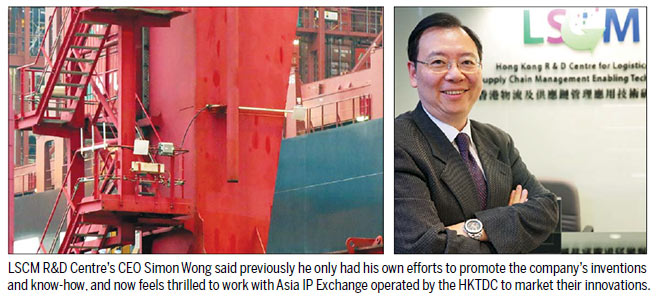Meshing minds to solve Wi-Fi issues
A HONG KONG TEAM HAS DEVELOPED A ‘MESH NETWORK’ TO FIX UNSTABLE OUTDOOR INTERNET CONNECTIONS
In a spacious and dynamic outdoor environment, such as a container terminal with moving cranes and containers, stable Wi-Fi connectivity cannot be taken for granted. But Wi-Fi remains a key component of a modern container terminal for logistics management. To tackle this challenge, the Hong Kong University of Science and Technology (HKUST) together with Open platform, a network software development specialist in Hong Kong, and the Hong Kong R&D Centre for Logistics and Supply Chain Management Enabling Technologies (LSCM R&D Centre) have jointly collaborated to create a patented technology called "mesh network" that resolves this exact problem.
"We developed a mesh network which can dynamically adjust its connectivity to offer 24/7 Wi-Fi service for the crew," said Gary Chan, a professor at HKUST who is the inventor of the technology. "The network addresses the harsh wireless environment where the blind spots keep changing."
The "mesh network" is a multi-hop Wi-Fi network, which features a mesh router that forwards data traffic from different mobile devices to the Internet Access Point (AP) in a hop-by-hop manner. The nodes intelligently decide which hop to relay its data to maximize user bandwidth experience, while eliminating blind spots through dynamic connectivity.
In 2007, Chan, whose research interests at HKUST include Wi-Fi, wireless networks, indoor localization, mobile computing and IT entrepreneurship, began to develop Wi-Fi technology for commercial use. Two years later, after gaining support from Open platform, which became directly involved in the technology’s development, Chan also got funding from the LSCM R&D Centre to successfully create the "mesh network". The technology is now being deployed at Kwai Tsing Container Terminals, supporting the crew’s daily work. The mesh network also won the Merit award in the Research and Development category in the 2012 Asia Pacific Information and Communications Technology Awards.
Among the 25,000 tradable intellectual properties listed on AsiaIPEX, the mesh network is one of the examples of the platform’s high quality and potential.
For the LSCM R&D Centre, a strategic partnership with AsiaIPEX is beneficial in helping the mesh network — and the center’s other technologies — to expand their reach and further their commercialization potential.
The LSCM R&D Centre’s Chief Executive Officer Simon Wong said: By grouping IPs together, we can increase the exposure and increase our chance of attracting attention."
He said it was important to use technology and innovation to further promote Hong Kong’s reputation as a logistics hub and new technologies that could help local companies become more efficient and competitive.
"Hong Kong is known for its logistics, supply chain management and end-to-end fulfillment, and there are a lot of goods that pass from the Chinese mainland through Hong Kong," Wong said. "The center’s technologies are developed from this expertise that can help both local companies upgrade their services and, of course, can be deployed internationally."
Although other mesh networks exist in the market, Bill Tang from Openplatform said the mesh network’s advantages are its speed and its fast, dynamic and intelligent routing protocol.
"It’s very fast," Tang said. "Unlike other mesh networks, it’s a mobile mesh network without the need of a central controller. Therefore, it can make timely decisions to adapt to dynamic environments. The router is not mounted on a fixed location but — in the case of the container terminal — on a moving crane."
In addition to the network, Chan also built software to support other real-world functionalities, including a user interface that is easy to use and can support automatic software updates. While the mesh network protocol is the technology core, Chan said that when deploying the technology in real-world situations, it is essential to consider how the technology can be operated and its ease of use.
While the mesh network has been adopted in a logistics environment, Tang pointed out that there are several other industries that could benefit from it. Where land cable installation is cost-prohibitive, a mesh network could provide an effective Wi-Fi solution. Another use is for areas such as heritage buildings where land installation might not be possible due to the building’s structure. "If there are historic buildings, for example, where you’re not able to use land cables but need to offer Internet connectivity, then a mesh network can provide that solution," Tang said.
When transferring the technology from the research and development center to the container terminal, Chan said he faced several challenges, specifically as they addressed the "harsh and dynamic industrial environment"of the container terminal, a significantly large area that needed stable 24/7 Wi-Fi coverage.
Chan says that platforms such as AsiaIPEX are beneficial for universities and research centers not only because they increase the exposure of the technologies, but also because he believes that IP trading is an ideal path for commercializing the technologies he develops. In addition, funding from the government and support from the LSCM R&D Centre are equally important in driving technology invention and adoption in the industry.
"IP licensing is a win-win situation," Chan said. "The technology can still be developed with a professor in collaboration with the industry, and the licensee has the benefit of the advice from the professor as it is being commercialized. In my opinion, licensing is the most viable option for commercializing the technology."

